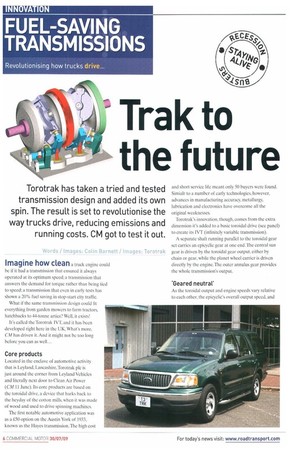Trak to the future
Page 46

Page 47

If you've noticed an error in this article please click here to report it so we can fix it.
Torotrak has taken a tried and tested transmission design and added its own spin. The result is set to revolutionise the way trucks drive, reducing emissions and running costs. CM got to test it out.
Words / Images: Colin Barnett / Images: Torotrak Imagine how clean a truck engine could be if it had a transmission that ensured it always
operated at its optimum speed; a transmission that answers the demand for torque rather than being tied to speed; a transmission that even in early tests has shown a 20% fuel saving in stop-start city traffic.
What if the same transmission design could fit everything from garden mowers to farm tractors, hatchbacks to 44-tonne artics? Well, it exists!
It's called the Torotrak 1VT, and it has been developed right here in the UK, What's more, CM has driven it. And it might not be too long before you can as well...
Core products
Located in the enclave of automotive activity that is Leyland, Lancashire, Torotrak plc is just around the corner from Leyland Vehicles and literally next door to Clean Air Power (CM 11 June). Its core products are based on the toroidal drive, a device that harks back to the heyday of the cotton mills, when it was made of wood and used to drive spinning machines.
The first notable automotive application was as a £50 option on the Austin York of 1933, known as the Hayes transmission. The high cost and short service life meant only 50 buyers were found. Simialr to a number of early technologies, however, advances in manufacturing accuracy. metallurgy, lubrication and electronics have overcome all the original weaknesses.
Throtrak's innovation, though, conies from the extra dimension it's added to a basic toroidal drive (see panel) to create its IVT (infinitely variable transmission).
A separate shaft running parallel to the toroidal gear set carries an epicyclic gear at one end. The central sun gear is driven by the toroidal gear output, either by chain or gear, while the planet wheel carrier is driven directly by the engine. The outer annulus gear provides the whole transmission's output.
'Geared neutral'
As the toroidal output and engine speeds vary relative to each other, the epicyclic's overall output speed, and hence the vehicle's road speed, varies. At a certain point in this speed relationship, the input speeds are effectively matched and the output gear becomes stationary. This "geared neutral" eliminates the need to disconnect drive at rest. Move the relationship even further and the effective output drive is reversed. With suitable electronic control, functions such as cruise control can also be incorporated.
So much for the theory...
Driving experience
Torotrak has a whole fleet of development vehicles on the road equipped with IVT, including a variety of cars. agricultural tractors and buses. We tried the system in an American Ford SUV which, despite its passenger pretensions, is comparable to a European light truck. For driver ease, it was still controlled by the original column-mounted PRND autobox quadrant, but in production applications it could be by any suitable electrical switching system.
The driving experience was something of an anticlimax. Moving away was just like any other auto 'box, except that the build up of speed was seamless, more like an electric motor than a mechanical device. On the roundabout-strewn dual-earn ageways across Leyland to the motorways, it simply accelerated when required with no lag. The most surreal part of the experience was on the motorway, watching the speedo at 70mph while the revs had fallen to tickover because that's where the engine was producing as much torque as the transmission needed to maintain mornentUrn.
Obvious benefits
It wasn't hard to see the benefits available to a heavy truck whose engine only ever produced the torque required. Engines could be developed to operate only within a narrow hut highly efficient speed range, avoiding fuel-wasting speed transitions and greatly improving emissions. The good news is that Torotrak is developing an application for at least one major European heavy truck manufacturer on a timetable that could see it in service in time for the Euro-6 deadline. This is one UK product you'll see more of, especially now that Allison Transmissions has bought a stake in the company. II












































































































































